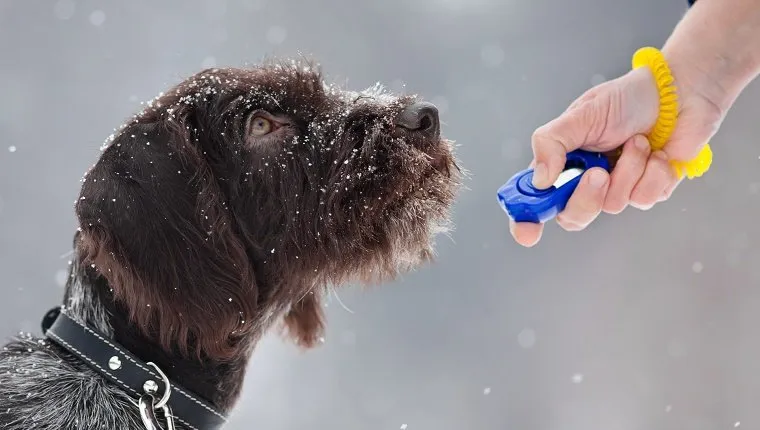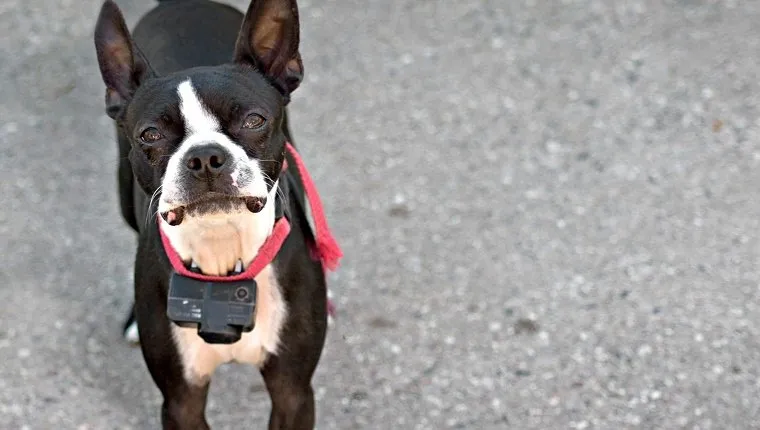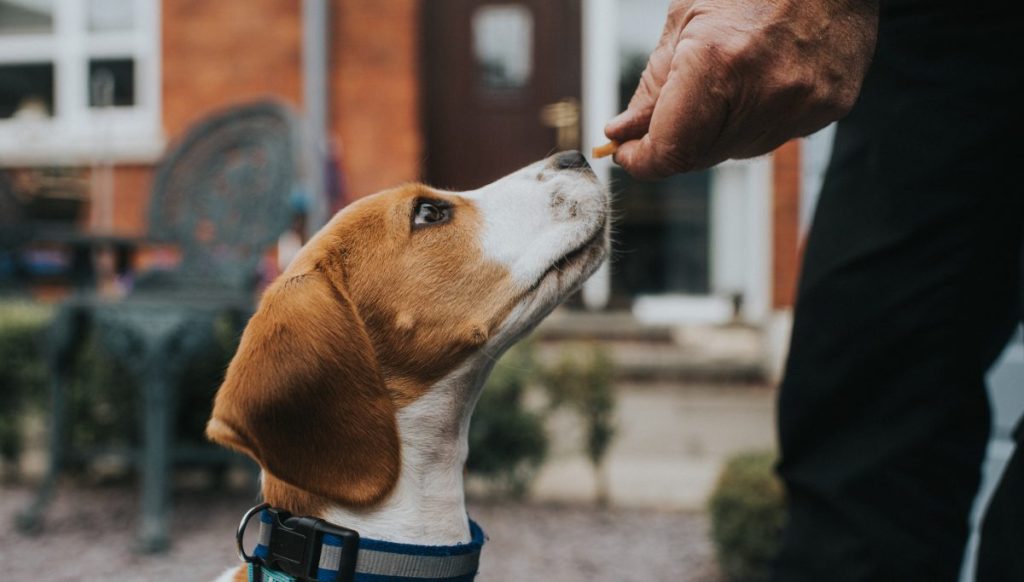There are so many popular dog training methods out there that it can be frustrating to find out which is which and what method is going to be best for both your dog and you as a pet parent. Here are the dog training methods used most widely today and who might benefit most from using them.
The most popular dog training methods
While our list isn’t exhaustive, the methods below are the most widely used and referred to ways of training a dog. Odds are, if you find a trainer they’ll be using one of these.
Positive Reinforcement
Purely positive reinforcement is a popular training method recommended by animal behaviorists, veterinarians, and dog trainers alike. The theory behind it is fairly straightforward. Unlike classical conditioning, such as Pavlov’s bell experiment, this method focuses on reinforcing voluntary good behavior with rewards. On the other hand, bad behavior does not receive a reward or acknowledgment. If a correction is needed, it comes in the form of removing rewards, such as taking away a toy or treats. Harsh reprimands or physical punishments are not necessary. This training method is not only beloved because it helps build trust between dogs and their pet parents, but because it is incredibly effective.
Positive reinforcement requires consistency. Start with continuous rewards every time your dog does the right thing. Then, gradually transition to intermittent rewards as the behavior becomes consistent. Only wanted behaviors should receive rewards, which can include treats, toys, praise, and petting. This training method works best with dog breeds who are eager to please and motivated by rewards like treats or praise.
Scientific Training

Science-based dog training can be difficult to define, as it relies on information that is continually building and changing. It aims to understand dogs’ nature, their ability to be conditioned, and the effectiveness of rewards and punishments. Animal behaviorists are constantly creating new studies and experiments to shape our understanding of dog psychology.
For the most part, there is a reliance on operant conditioning, which mostly includes positive reinforcement and, less often, some forms of punishment. Some scientific trainers believe that it’s also important to learn how to strengthen good behavior without the need for rewards and to rely on dog psychology to find ways to improve off-leash relationships between humans and their pups. Scientific training relies on doing a good deal of research and staying updated on the latest studies. For that reason, it may be best for professional trainers.
Clicker Training

Clicker training is also based on operant conditioning and relies heavily on the same principles as positive reinforcement. Sometimes this method is considered a sub-category of positive reinforcement rather than its own method.
This training method relies on the use of a device to make a quick, sharp noise, such as a whistle or, as the name suggests, a clicker to signal to a dog when a wanted behavior is accomplished. The advantage of using clicker training is that it signals the exact moment the desired behavior is finished and exactly what is being rewarded. Trainers can then use the clicker to shape new behaviors and add verbal commands.
Clicker training is a great method for learning new tricks, and it can help shape the basics into more complicated tasks. Many professional trainers use this method for teaching new behaviors, although it may not necessarily be well-suited for curbing unwanted behaviors. Furthermore, some studies suggest that the clicker functions more as a secondary reinforcement, similar to verbal praise, rather than a primary one.
Electronic Training

Electronic training relies on the use of an electric collar that delivers a shock, sound, vibration, or a spray of citronella when a dog is not performing a desired task. There are significant concerns with this training method, and shock collars have been banned in some European and South American countries due to animal welfare issues. Additionally, its effectiveness is questionable, as it relies on punishment rather than positive reinforcement. This means dogs learn what not to do rather than what they should do.
While some proponents argue it helps correct unwanted behaviors, particularly aggression, aggression often stems from fear. Using a method that reinforces fear can ultimately create more behavioral issues rather than resolving them. Additionally, this can create a great deal of stress and lead to permanent anxiety issues for dogs. The devices are often used by inexperienced pet parents and therefore are overused. As a result, this can cause a lot of unnecessary physical and psychological pain for dogs. However, some animal behaviorists and veterinarians agree that some electronic training methods, such as sound cues or vibrations emitted from collars can help curb some habits like excessive barking. If you’re considering using any form of electronic dog training, do your research and speak to your veterinarian about safety and alternative options.
Model-Rival Or Mirror Training
The model-rival method of training relies on the fact that dogs learn by observation. In contrast to operant methods, this technique provides a model of good behavior or a rival to compete for resources, encouraging dogs to learn to mimic or avoid certain behaviors. A trainer might have another human act as the model, praising them for completing tasks on command or scolding them for unwanted behavior. The dog, as an observer, learns what to do correctly from the model. The model can also act as a rival, competing to do the right task for a desired toy or treat it as a reward, encouraging the dog to pick up on the task and accomplish it more quickly.
Similarly, mirror training relies on the same principle of using the dog parent as a model. To put it simply, the dog learns by example. This training method operates with a similar level of success as positive reinforcement and operant conditioning. However, some trainers may find it more natural and preferable.
If your dog has a strong bond with you and can spend a lot of time observing you and following you around, this may be a technique that you find more comfortable than sticking to regular training sessions.
Alpha Dog Or Dominance

Alpha dog, or dominance training, is based on the idea that dogs view their families as packs with a strict social hierarchy. If a dog sees itself as the alpha, it must learn to submit to its human leader. This method involves projecting confidence, controlling resources, and asserting dominance — such as making the dog wait before eating, entering a room, or going outside. Dogs are often kept off furniture and not engaged at the same eye level to reinforce human authority. This means no getting low with the dog during play and no snuggles. Essentially, man is dominant.
Although popularized by renowned dog trainer Cesar Millan, also known as “The Dog Whisperer,” this approach is now viewed as outdated by many modern trainers. Research shows that wild wolves do not follow the rigid pack structure seen in captivity. Wolves are very social and exhibit many behaviors similar to humans. The alpha wolf will even roll over and play with other wolves. However, this does not diminish his role as the pack leader.
To that end, dogs don’t rely on dominance-based relationships as previously thought. While this method may curb some behaviors, it often fails to address their root causes and can create fear or anxiety.
Relationship-Based Training

Relationship-based training blends multiple methods with a personalized approach, emphasizing communication and a strong bond between dog and owner. It requires understanding a dog’s body language, identifying motivating rewards, and meeting their basic needs before training begins. The environment is controlled to optimize learning, similar to how children are taught.
Training starts in a distraction-free setting, gradually increasing difficulty. For example, a dog should learn to “sit” in a quiet room before attempting it in a busy park. When a dog doesn’t respond, the owner should assess why — distractions, discomfort, or lack of understanding — rather than resorting to punishment. Managing temptation is also key; for instance, if a dog jumps at the window, restricting access prevents the behavior.
While this method fosters a deep bond, it requires patience and time. Rather than being a distinct technique, it integrates elements of various successful training approaches.
Choosing the best training method for your dog can be overwhelming, and even experts disagree on the most effective and ethical approaches. Many methods overlap or work best in combination, as dogs, like humans, learn in different ways. The golden rule is to not harm — breaking your dog’s trust will only make training harder. Patience is key!









